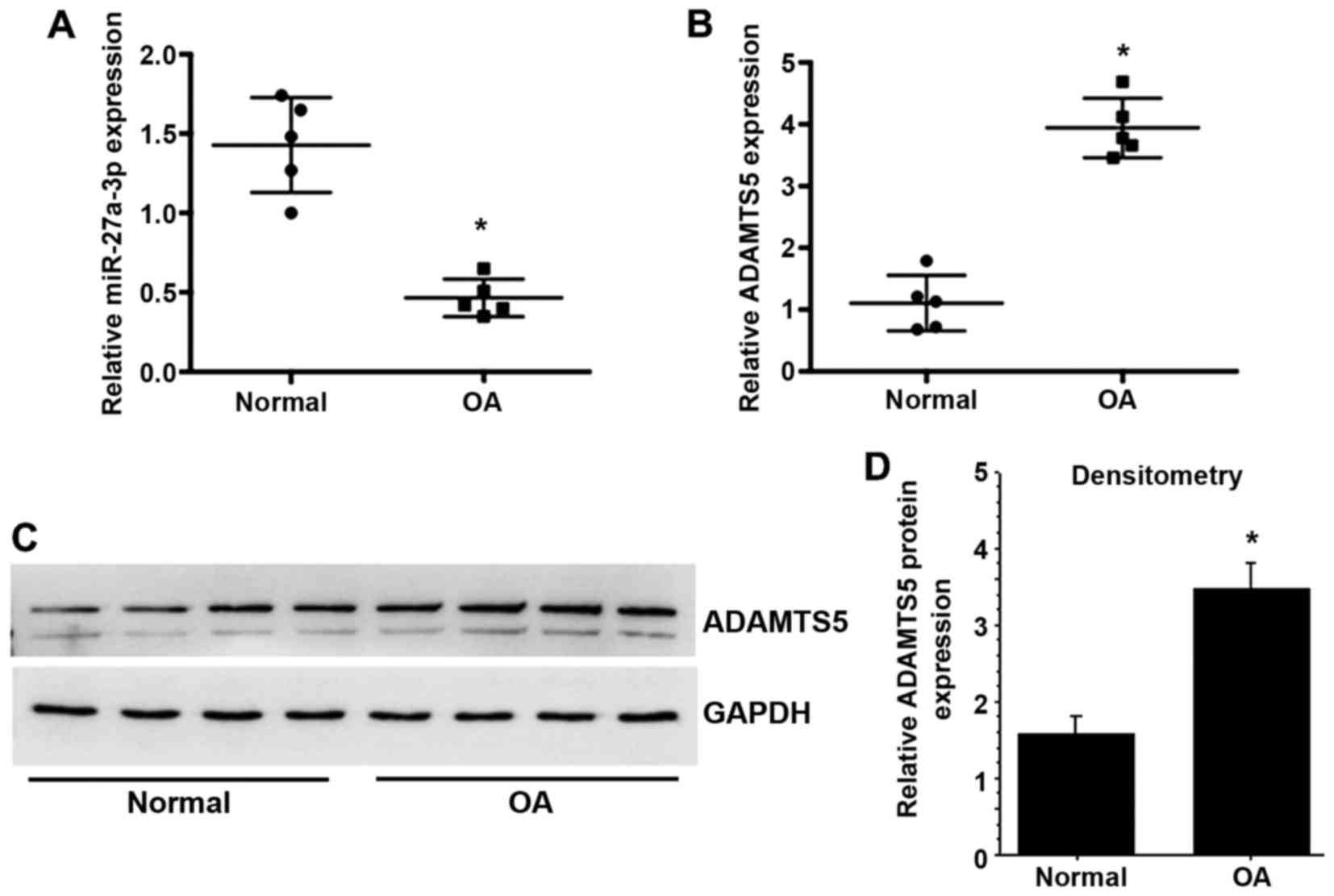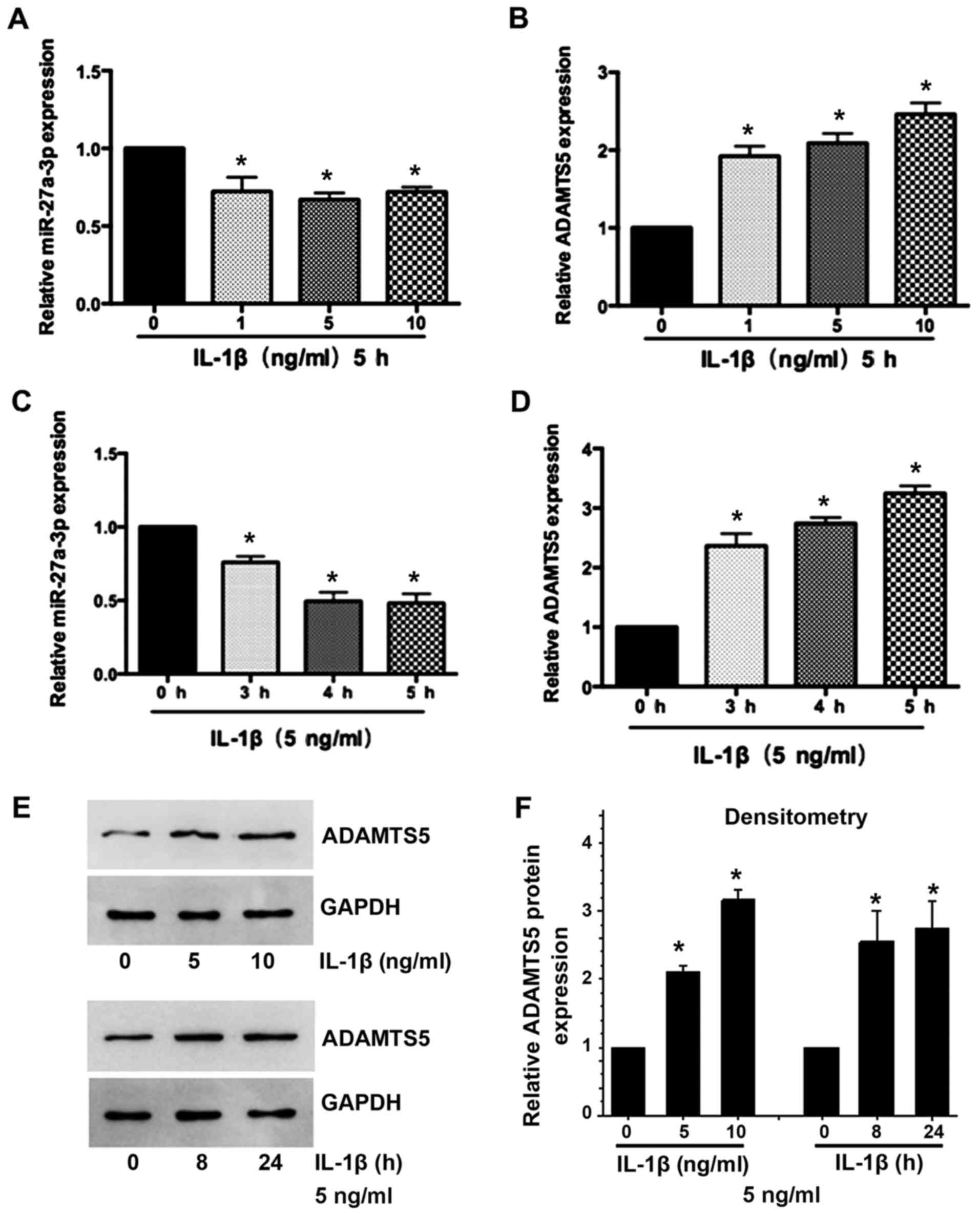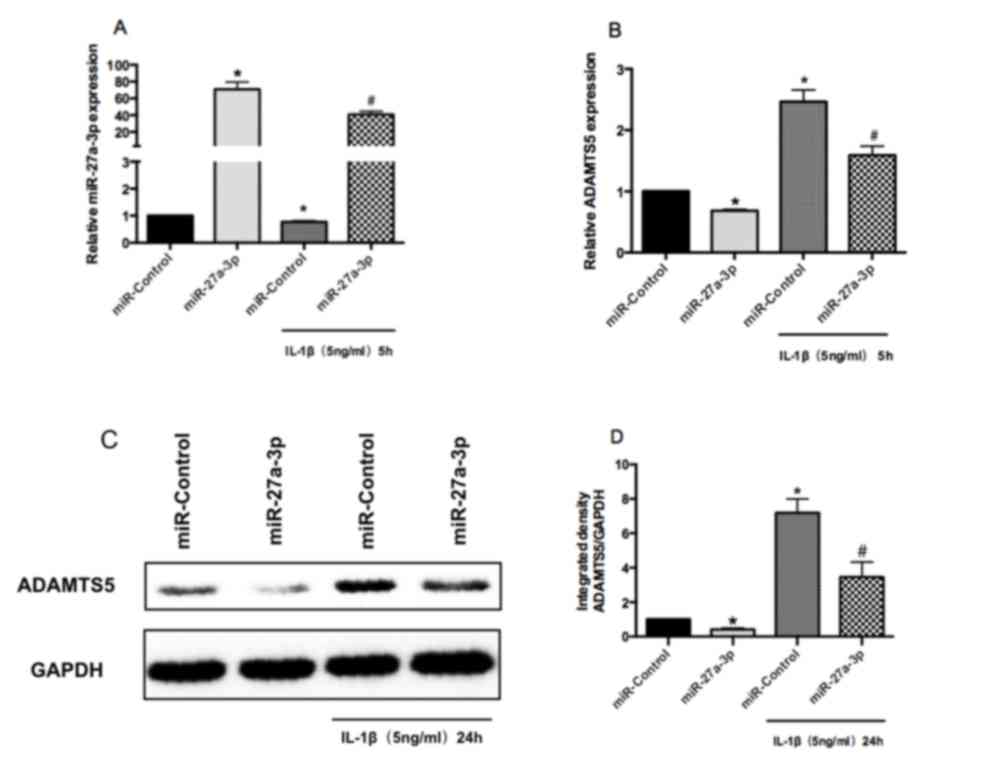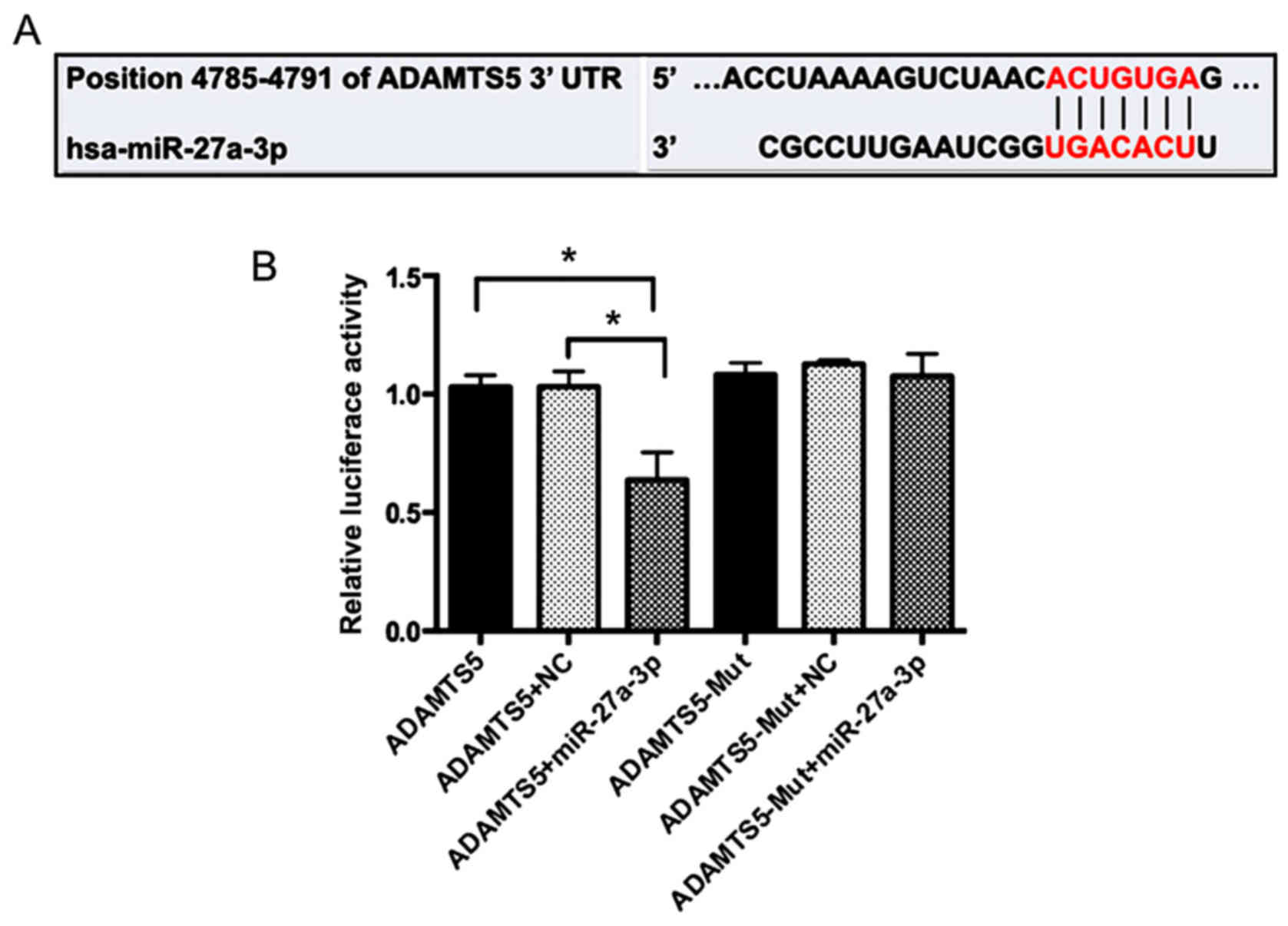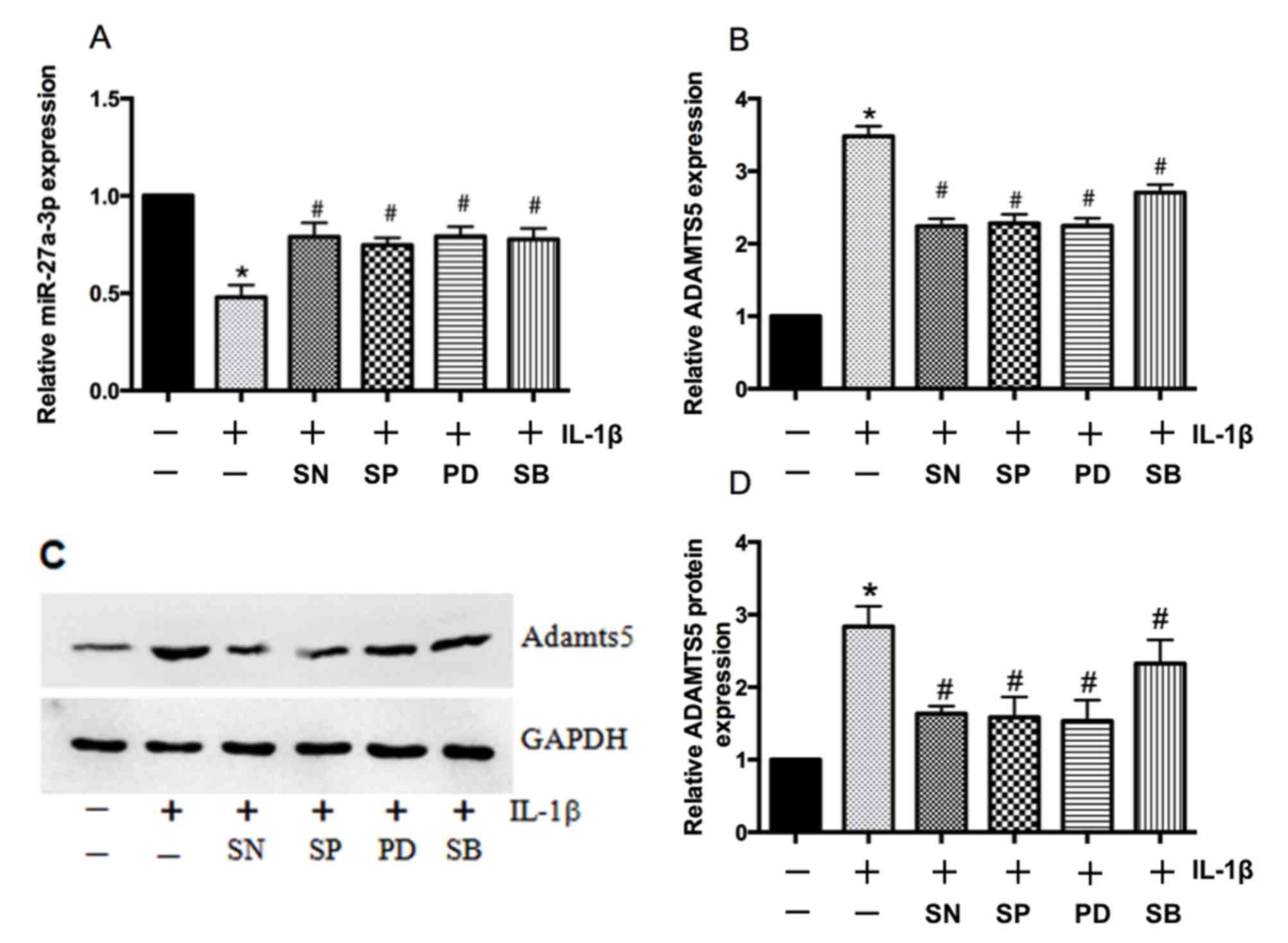Interleukin‑1β‑mediated suppression of microRNA‑27a‑3p activity in human cartilage via MAPK and NF‑κB pathways: A potential mechanism of osteoarthritis pathogenesis
- Authors:
- Published online on: May 4, 2018 https://doi.org/10.3892/mmr.2018.8970
- Pages: 541-549
Abstract
Introduction
Osteoarthritis (OA) is a multifactorial disease that is characterized by biochemical and morphological alterations resulting from unbalanced cartilage anabolism and catabolism, and is a primary cause of pain and disability in the elderly population (1,2). Although the understanding of the exact mechanism of OA pathogenesis remains incomplete, the inflammatory response is considered to be implicated in the development and progression of OA (3). Interleukin (IL)-1β, which controls the degradation of articular cartilage matrix, is among the mediators involved in the disturbance of metabolic processes in OA pathophysiology (4). The catabolic effects of IL-1β are primarily mediated through the activation of various signaling pathways, including mitogen-activated protein kinase (MAPK) and nuclear factor (NF)-κB (4). Previous studies have demonstrated that aggrecanase-2 (ADAMTS5) is a major factor involved in OA (5), and inhibition of ADAMTS5 has been reported to prevent cartilage degradation in an animal OA model (6). Thus, ADAMTS5 regulation may be regarded as a rational strategy for therapeutic intervention in OA (7).
MicroRNAs (miRNAs/miRs) are a class of regulative non-coding RNA with a length of 18–23 nucleotides that function in the post-transcriptional regulation of gene expression. miRNAs serve critical roles in multiple biological processes in human diseases (1). Previous studies have reported differential miRNAs expression patterns among OA, normal plasma (8), synovial fluid (9) and cartilage (10). A previous study demonstrated that miRNAs participated in the ‘tug-of-war’ between tissue homeostasis and OA pathogenesis (11). Further studies have demonstrated that dysregulation of miR-27a was involved in cardiovascular risk (12), neuronal autophagy in brain injury (13) and prostate cancer progression (14). In addition, treatment with anti-miR-27a significantly increased the expression of matrix metallopeptidase (MMP)-13 in human osteoarthritic chondrocytes (15). Certain miRNAs have been confirmed to serve an important role in OA pathogenesis and disease progression through the regulation of ADAMTS5 expression (16,17). However, whether miR-27a-3p regulates the expression of ADAMTS5 in primary normal chondrocytes and its role during the progression of OA remains to be determined.
The present study focused on the role of miR-27a-3p in OA development and the associated underlying mechanisms.
Materials and methods
Human cartilage collection
The consent and study plan was approved by the Ethics Committee on Human Experimentation at the First Affiliated Hospital of Sun Yat-sen University (Guangzhou, China; IRB: 2011011) and complied with the Declaration of Helsinki 2000. All participants provided written informed consent. Femoral condyles or tibial plateaus were selected as specimens. Human OA cartilage was obtained from knee joints at the time of total knee replacement operation (n=5, aged 59–72 years). OA was diagnosed according to the American College of Rheumatology (18). Normal cartilage samples were taken from patients (n=5, aged 11–28 years), who suffered from various types of bone/soft tissue cancer affecting the thigh/ilium and had amputation of the thigh. Patient information is presented in Table I.
Primary chondrocyte isolation and cell culture
Articular cartilage tissues obtained from normal articular cartilage were broken up into small pieces (<1 mm3) and digested sequentially in pronase (Roche Diagnostics, Basel, Switzerland) at 37°C for 90 min and collagenase P (Roche Diagnostics) for 12 h at 37°C on a stirring plate. Isolated primary human articular chondrocytes were seeded into flasks containing Dulbecco's Modified Eagle's medium/F12 (Gibco; Thermo Fisher Scientific, Inc., Waltham, MA, USA) supplemented with 5% fetal bovine serum, 1% penicillin and 1% streptomycin at 37°C and 5% CO2. The medium was replaced every three days. First-passage chondrocytes were used for subsequent experiments.
Computational prediction of miR-27a-3p target gene
The miRNA target prediction software miRanda (http://www.microrna.org) and the TargetScan Database (http://www.targetscan.org/) were employed to predict miR-27a-3p binding sites in human 3′UTRs as described in a previous study (19), and only those identified by two software were selected for further study.
Treatment with IL-1β and transfection
When the cells reached 80% confluence, 1×106 cells were seeded into 6-well plates for recombinant human IL-1β (PeproTech, Inc., Rocky Hill, NJ, USA) treatment and stimulated with 0, 1, 5 or 10 ng/ml IL-1β for 0, 3, 4, 5, 8 or 24 h (0–5 h for RNA extraction and 0–24 h for protein extraction). For miR-27a-3p overexpression experiments, 2×104 primary human chondrocytes were transfected with 50 nM miR-27a-3p mimic (5′-UUCACAGUGGCUAAGUUCCGC-3′; Guangzhou RiboBio, Co., Ltd., Guangzhou, China) using Lipofectamine® 2000 (Gibco; Thermo Fisher Scientific, Inc.), according to the manufacturer's protocol. miR-Control (cat. no. miR01101; Guangzhou RiboBio, Co., Ltd.) with 50 nM was used as a control. After 24 h transfection, the cells were treated with IL-1β (5 ng/ml) at 37°C for 5 and 24 h to collect the mRNA and protein, respectively. For the involvement of NF-κB and MAPK signaling pathways investigation, 1×106 primary human chondrocytes were treated with pathway-specific inhibitors. The NF-κB inhibitor, SN50 (5 µM) and various MAPK inhibitors, including SB203580 (1 µM), PD98059 (10 µM) and SP600125 (10 µM) (p38, MEK-1/2 and c-Jun N-terminal kinase inhibitors, respectively), were used to treat cells for 2 h prior to the exposure of IL-1β, which was followed by treatment with IL-1β (5 ng/ml; 5 h for RNA extraction and 24 h for protein extraction) at 37°C. The cells were then harvested for subsequent experiments.
Reverse transcription-quantitative polymerase chain reaction (RT-qPCR)
Total RNA was extracted from cartilage tissues and chondrocytes using TRIzol (Invitrogen; Thermo Fisher Scientific, Inc.). cDNA was generated using the PrimeScript® miRNA cDNA Synthesis kit (Takara Biotechnology, Inc.). To analyze miR-27a-3p expression, qPCR was performed using SYBR Premix Ex Taq II (Takara Bio, Inc., Otsu, Japan) on a CFX96 Real-Time PCR detection system (Bio-Rad Laboratories, Inc., Hercules, CA, USA). miR-27a-3p expression was normalized to U6 expression (20). For GAPDH and ADAMTS5, total RNA was reverse transcribed using the miRNeasy Mini kit (Qiagen Sciences, Inc., Gaithersburg, MD, USA) and qPCR was performed using the SYBR green system (Takara Bio, Inc.) (21). GAPDH was used as a reference. Relative expression levels were quantified by the 2−ΔΔCq method (22). Each experiment was repeated three times and each assay was performed in triplicate. All primers were designed by Sangon Biotech Co., Ltd., (Shanghai, China). Gene-specific primer pairs were as follows: ADAMTS5 forward, 5′-AATGCACTTCAGCCACCATCA-3′ and reverse, 5′-TCGTAGGTCTGTCCTGGGAGTTC-3′; GAPDH forward, 5′-GCACCGTCAAGGCTGAGAAC-3′ and reverse, 5′-TGGTGAAGACGCCAGTGGA-3′. The primer sequence for RT-PCR miR-27a-3p forward, 5′-TTCACAGTGGCTAAGTTCCGC-3′, miRNA-specific primer was provided by Mir-X miRNA qRT-PCR SYBR kits; U6 forward, 5′-GCTTCGGCAGCACATATACTAAAAT-3′ and reverse, 5′-CGCTTCACGAATTTGCGTGTCAT-3′.
Western blot analysis
Western blot experiments were performed according to standard methods. Total protein was isolated from primary human chondrocytes or cartilage tissues. Cells were placed on ice immediately following treatments washed with ice-cold PBS and harvested in Mammalian Protein Extraction Reagent buffer (Pierce; Thermo Fisher Scientific, Inc.). All of the wash buffers and Mammalian Protein Extraction Reagent buffer included a 1X protease inhibitor mixture (Roche Diagnostics), NaF (5 mM) and Na3VO4 (200 µM). The concentration of the protein was detected by the bicinchoninic acid method. Subsequently, 50 mg total cell proteins from each sample was resolved by 10% SDS-PAGE and transferred by electroblotting to polyvinylidene difluoride membranes (EMD Millipore, Billerica, MA, USA). The membranes were blocked with 5% nonfat dry milk in 0.1% TBS-Tween-20 (TBST) at 37°C for 1 h and subsequently incubated overnight at 4°C in 5% nonfat dry milk in TBST with a primary antibody against ADAMTS5 (1:1,000 dilution; cat. no. ab135656; Abcam, Cambridge, UK). A primary antibody against GAPDH (1:2,000 dilution, cat. no. 5174S; Cell Signaling Technology, Inc.) was also used. After washing, the membranes were incubated with anti-rabbit antibody (1:3,000; cat. no. 111-035-003; Jackson ImmunoResearch Laboratories, Inc., West Grove, PA, USA) conjugated to horseradish peroxidase at 37°C for 1 h and proteins were detected using Enhanced Chemiluminescence Plus reagent (Invitrogen; Thermo Fisher Scientific, Inc.) and an ImageQuant LAS 4000 Mini detection system (GE Healthcare Life Sciences, Little Chalfont, UK). Densitometric analysis was performed using ImageJ software version 1.39 (National Institutes of Health, Bethesda, MD, USA).
Dual luciferase assays
DNA sequences of the ADAMTS5 3′untranslated region (3′UTR) were amplified by PCR (98°C 10 sec; 55°C 5 sec or 15 sec; 72°C 1 min/kb; 30 cycles), and used the Prime STAR HS DNA Polymerase (Takara Bio, Inc.). The amplified DNA sequences were cloned into the pMIR-REPORT Luciferase (Obio Technology Corp., Ltd., Shanghai, China) and the restriction enzymes used were Mlu and Hind III (NEB), and co-transfected using Lipofectamine 2000 (Thermo Fisher Scientific, Inc., with the control or hsa-miR-27a-3p into 293 cells (purchased from American Type Culture Collection, Manassas, VA, USA). The DNA sequence of ‘ADAMTS5 3′UTR’ was amplified on the genomic DNA. The primers that were used for amplification are H4597-4-1 and H4597-4-2, the sequence for H4597-4-1 is 5′-ATAGGCCGGCATAGACGCGTCAACTTAACTGGCTAGTACATTG-3′, and H4597-4-2 is 5′-AAAGATCCTTTATTAAGCTTTACTTTAACCTAGTTTACAATTTATATTTATTATG-3′. The sequencing primers for ADAMTS5 3′UTR Vector are Luc-C-F, M13F and H4597-F1, with Luc-C-F: GAGGAGTTGTGTTTGTGGAC, M13F: TGTAAAACGACGGCCAGT, and H4597-F1: GTGAGGAAAACTGTGATTTGTAGG.
For the dual luciferase assay, 1.2×104 293 cells in a 96-well plate were transfected with 50 nM miR-27a-3p or miR-NC (Guangzhou RiboBio Co., Ltd.). The cells were then co-transfected with 2 mg/ml of vector with the wild-type or mutant 3′UTR of ADAMTS5 gene. Cell lysates were harvested 48 h after transfection and luciferase activity was determined using the Dual-Luciferase® Reporter Assay System (Promega Corporation, Madison, WI, USA). Firefly luciferase values were normalized to the Renilla signal, and the ratio of the Firefly/Renilla values was determined. All experiments were performed in triplicate.
Statistical analysis
Continuous data are presented as the mean ± standard deviation. One-way analysis of variance or Student's t-tests were used to identify significant differences among or between groups. P<0.05 was considered to indicate a statistically significant difference. Data were analyzed using SPSS statistical software version 19.0 (IBM Corp., Armonk, NY, USA). All experiments were performed at least three times.
Results
Expression levels of miR-27a-3p and ADAMTS5 in normal and OA cartilage
To investigate the potential effect of miR-27a-3p in the progression of OA, the present study determined the expression of miR-27a-3p in normal and OA articular cartilage. The results demonstrated that miR-27a-3p expression was significantly decreased in OA cartilage compared with normal cartilage (Fig. 1A), while the mRNA and protein expression levels of ADAMTS5 were significantly upregulated in OA cartilage compared with normal cartilage (Fig. 1B-D).
IL-1β suppresses miR-27a-3p expression and induces ADAMTS5 expression in primary human chondrocytes
Subsequently, the present study determined the expression of miR-27a-3p and ADAMTS5 in IL-1β-stimulated human chondrocytes. Decreased miR-27a-3p (Fig. 2A and B) and increased ADAMTS5 mRNA and protein (Fig. 2C-F) expression was observed in a time- and dose-dependent manner in chondrocytes treated with IL-1β. These results indicated that there may be a negative association between miR-27a-3p and the expression of ADAMTS5 in the development of OA.
miR-27a-3p inhibits ADAMTS5 expression in human chondrocytes
RT-qPCR was performed to confirm the successful overexpression of miR-27a-3p in human chondrocytes (Fig. 3A). RT-qPCR and western blot analysis demonstrated that overexpression of miR-27a-3p suppressed the mRNA and protein expression of ADAMTS5 in human chondrocytes, compared with miR-Control-transfected cells (Fig. 3B-D). Furthermore, miR-27a-3p overexpression downregulated IL-1β-induced increases in the mRNA and protein expression of ADAMTS5 in human chondrocytes (Fig. 3B-D). These results indicated that the expression of ADAMTS5 may be downregulated by miR-27a-3p in human chondrocytes.
miR-27a-3p targets the 3′UTR of ADAMTS5 mRNA
To further clarify the molecular mechanisms that underlie the regulation of ADAMTS5 expression by miR-27a-3p, the sequence in the 3′UTR of ADAMTS5 gene was analyzed. Bioinformatics prediction such as miRanda (http://www.microrna.org) and the TargetScan Database (http://www.targetscan.org/) demonstrated that ADAMTS5 may be a potential miR-27a-3p target gene (Fig. 4A). 293 cells were co-transfected with miR-27a-3p mimics or miR-Control and wild-type or mutant ADAMTS5 plasmids. A double-luciferase reporter gene system demonstrated that the miR-27a-3p mimics had no significant effect on the luciferase activity of the mutant ADAMTS5 plasmid, but significantly decreased the luciferase activity of the wild-type reporter plasmid compared with those co-transfected with miR-Control (P<0.05; Fig. 4B). These results indicated that ADAMTS5 may be a direct target of miR-27a-3p.
IL-1β regulates miR-27a-3p expression via NF-κB and MAPK signaling pathways in chondrocytes
A previous study confirmed that IL-1β induced the activation of NF-κB and MAPK in human chondrocytes (23), and IL-1β has also been reported to modulate the transcription of MMPs and tissue inhibitor of metallopeptidases via NF-κB and MAPK (24). To determine whether the NF-κB and MAPK signaling pathways may regulate IL-1β-dependent expression of miR-27a-3p and ADAMTS5, primary human chondrocytes were treated with pathway-specific inhibitors. Compared with IL-1β treatment alone, the expression of miR-27a-3p was enhanced by pretreatment with NF-κB and MAPK inhibitors (Fig. 5A) and ADAMTS5 expression was suppressed at both the mRNA and protein levels (Fig. 5B-D). These results indicated that the effect of IL-1β on miR-27a-3p and ADAMTS5 expression in human chondrocytes may be associated with the activation of the NF-κB and MAPK signaling pathways.
Discussion
Disruptions in extracellular matrix (ECM) homeostasis are key events in the pathogenesis of OA (25) and ADAMTS5 has a key role in ECM homeostasis due to its capacity to degrade a wide range of ECM components (26). The current study demonstrated that the expression of miR-27a-3p was significantly lower in OA cartilage compared with normal cartilage, while the overexpression of miR-27a-3p in human chondrocytes inhibited ADAMTS5 expression. In addition, the expression levels of ADAMTS5 and miR-27a-3p were demonstrated to be mediated by IL-1β, which may be associated with the activation of the NF-κB and MAPK signaling pathways. Mutation of the miR-27a-3p binding site in the 3′-UTR of ADAMTS5 mRNA abolished miR-27a-3p-mediated repression of reporter activity. Overall, the results of the present study indicated that miR-27a-3p may serve a role in regulating the expression of ADAMTS5 in OA.
Aggrecan depletion in arthritic cartilage has been considered to be the primary pathological feature of OA (27). During OA development, ADAMTS5 activity is regulated at the transcriptional level and via post-translational modifications and the proprotein may be processed by various convertases or proteases, including furin, proprotein convertase 7 and syndecan 4 (28,29). Previous studies have investigated the pathogenesis of OA using ADAMTS4/5 knockout mice, the results of which revealed that inhibition of ADAMTS5, but not ADAMTS4, relieved aggrecan degradation and cartilage destruction, which indicated that ADAMTS5 served a role in OA cartilage aggrecan degradation in mice (5,6). Consistent with previously published data (30), the present study demonstrated that ADAMTS5 was upregulated in human OA cartilage compared with normal cartilage.
The catabolic and anabolic effects of miRNAs on OA cartilage has received attention (31). miRNAs have also been reported to be involved in the pathogenesis of ADAMTS5-associated OA. miRNA-140-knock-out mice developed OA-like features, which were attributed to the elevated expression of ADAMTS5 (29). In addition, IL-1β suppressed the expression of miRNA-140 in chondrocytes in vitro (32) and Miyaki et al (29) reported that miR-140 downregulated ADAMTS5 expression in IL-1β-induced OA chondrocytes. Furthermore, Hu et al (33) reported that miR-302, nuclear receptor subfamily 2 group F member 2 and octamer-binding transcription factor 4 may be involved in a novel mechanism for understanding and inducing pluripotency in somatic cells, and that NR2F2 may be directly targeted by miR-302. Liang et al (34) demonstrated that miR-302 was downregulated in irradiated breast cancer cells and is a potential sensitizer to radiotherapy. However, the role of miR-27a-3p in OA and whether miR-27a-3p regulates ADAMTS5 remains unknown. In the present study, miR-27a-3p was downregulated in OA cartilage compared with normal cartilage. The overexpression of miR-27a-3p inhibited the expression of ADAMTS5 in human chondrocytes. These observations, along with the results of the luciferase reporter assay, indicated that miR-27a-3p may interact with the 3′UTR of ADAMTS5 mRNA and downregulate its expression at the post-transcriptional level. These results indicated that miR-27a-3p may serve important roles in the pathogenesis and development of OA.
Cartilage matrix degradation may be stimulated and enhanced by cytokines, such as IL-1β or tumor necrosis factor-α, which promote aggrecan degradation through the regulation of MMPs and aggrecanases (35). IL-1β may stimulate ADAMTS5 expression, which leads to cartilage extracellular matrix degradation. A previous study demonstrated a critical role of miR-30a in regulating IL-1β-meditated OA pathogenesis and provided novel insight into the mechanisms of cytokine modulation of ADAMTS5 expression (30). In the present study, IL-1β treatment repressed miR-27a-3p expression in chondrocytes. It was also demonstrated that IL-1β-induced suppression of miR-27a-3p was reversed by NF-κB and MAPK inhibitors. A similar induction of ADAMTS5 in OA by NF-κB and MAPK activation was previously reported (36). These results indicate that miR-27a-3p may serve an important role in the degeneration of cartilage and may be regulated by NF-κB and MAPK catabolic pathways in chondrocytes.
The current study has several limitations. Only 5 unpaired samples were used, and studies with a higher number of samples with similar age should be performed to confirm these results. Although it is difficult to collect more normal cartilage in a short time because of the limited number of patients undergoing the right type of surgery to obtain these tissues and who are willing to enroll in the study, therefore greater numbers will be collected to enhance validity in the future. Another limitation is that the current study only focused on the regulation of ADAMTS5 by miR-27a-3p; the regulation of aggrecan degradation by miR-27a-3p will be investigated in future studies. In addition, the present study primarily consisted of in vitro experiments, and in vivo experiments should be performed in future studies.
In conclusion, this study demonstrated that miR-27a-3p was downregulated in human OA and was suppressed by IL-1β, acting as a crucial regulator of ADAMTS5, in OA chondrocytes. The data may provide insight into the roles of miR-27a-3p in OA pathogenesis as a therapeutic target for OA.
Acknowledgements
Not applicable.
Funding
The present study was supported by the Guangdong Natural Science Foundation (grant no. 2016A030313259), the Startup Foundation for Doctors of the Guangdong Natural Science Foundation (grant no. 2015A030310451), the National Natural Science Foundation of China (grant no. 81401840) and Sun Yat-sen University Starting Funds for Young Teachers (grant no. 16ykpy31).
Availability of data and materials
All data generated or analyzed during this study are included in this published article.
Authors' contributions
PH and HW conceived and designed the study. XL, YK, ZL and HXW performed the experiments. HW, ZL and HXW wrote the paper. YX, ML and DX analyzed the data. All authors read and approved the final manuscript.
Ethics approval and consent to participate
The study was approved by the Ethics Committee on Human Experimentation at the First Affiliated Hospital of Sun Yat-Sen University (Guangzhou, China; IRB: 2011011). Written informed consent was obtained from all participants.
Consent for publication
Not applicable.
Competing interests
The authors declare that they have no competing interests.
Glossary
Abbreviations
Abbreviations:
|
OA |
osteoarthritis |
|
ADAMTS5 |
aggrecanase-2 |
|
ECM |
extracellular matrix |
|
MAPK |
mitogen-activated protein kinase |
|
miRNA |
microRNA |
References
|
Jin R, Shen M, Yu L, Wang X and Lin X: Adipose-derived stem cells suppress inflammation induced by IL-1β through down-regulation of P2X7R mediated by miR-373 in chondrocytes of osteoarthritis. Mol Cells. 40:222–229. 2017.PubMed/NCBI | |
|
Blalock D, Miller A, Tilley M and Wang J: Joint instability and osteoarthritis. Clin Med Insights Arthritis Musculoskelet Disord. 8:15–23. 2015. View Article : Google Scholar : PubMed/NCBI | |
|
Berenbaum F: Osteoarthritis as an inflammatory disease (osteoarthritis is not osteoarthrosis!). Osteoarthritis Cartilage. 21:16–21. 2013. View Article : Google Scholar : PubMed/NCBI | |
|
Kapoor M, Martel-Pelletier J, Lajeunesse D, Pelletier JP and Fahmi H: Role of proinflammatory cytokines in the pathophysiology of osteoarthritis. Nat Rev Rheumatol. 7:33–42. 2011. View Article : Google Scholar : PubMed/NCBI | |
|
Stanton H, Rogerson FM, East CJ, Golub SB, Lawlor KE, Meeker CT, Little CB, Last K, Farmer PJ, Campbell IK, et al: ADAMTS5 is the major aggrecanase in mouse cartilage in vivo and in vitro. Nature. 434:648–652. 2005. View Article : Google Scholar : PubMed/NCBI | |
|
Glasson SS, Askew R, Sheppard B, Carito B, Blanchet T, Ma HL, Flannery CR, Peluso D, Kanki K, Yang Z, et al: Deletion of active ADAMTS5 prevents cartilage degradation in a murine model of osteoarthritis. Nature. 434:644–648. 2005. View Article : Google Scholar : PubMed/NCBI | |
|
Deng H, O'Keefe H, Davie CP, Lind KE, Acharya RA, Franklin GJ, Larkin J, Matico R, Neeb M, Thompson MM, et al: Discovery of highly potent and selective small molecule ADAMTS-5 inhibitors that inhibit human cartilage degradation via encoded library technology (ELT). J Med Chem. 55:7061–7079. 2012. View Article : Google Scholar : PubMed/NCBI | |
|
Cuadra Borgonio VM, González-Huerta NC, Romero-Córdoba S, Hidalgo-Miranda A and Miranda-Duarte A: Altered expression of circulating microRNA in plasma of patients with primary osteoarthritis and in silico analysis of their pathways. PLoS One. 9:e976902014. View Article : Google Scholar : PubMed/NCBI | |
|
Xu JF, Zhang SJ, Zhao C, Qiu BS, Gu HF, Hong JF, Cao L, Chen Y, Xia B, Bi Q and Wang YP: Altered microRNA expression profile in synovial fluid from patients with knee osteoarthritis with treatment of hyaluronic acid. Mol Diagn Ther. 19:299–308. 2015. View Article : Google Scholar : PubMed/NCBI | |
|
Díaz-Prado S, Cicione C, Muiños-López E, Hermida-Gómez T, Oreiro N, Fernández-López C and Blanco FJ: Characterization of microRNA expression profiles in normal and osteoarthritic human chondrocytes. BMC Musculoskelet Disord. 13:1442012. View Article : Google Scholar : PubMed/NCBI | |
|
Goldring MB and Marcu KB: Epigenomic and microRNA-mediated regulation in cartilage development, homeostasis, and osteoarthritis. Trends Mol Med. 18:109–118. 2012. View Article : Google Scholar : PubMed/NCBI | |
|
Arroyo B A, Salloum-Asfar S, Pérez-Sánchez C, Teruel-Montoya R, Navarro S, García-Barberá N, Luengo-Gil G, Roldán V, Hansen JB, López-Pedrera C, et al: Regulation of TFPIα expression by miR-27a/b-3p in human endothelial cells under normal conditions and in response to androgens. Sci Rep. 7:435002017. View Article : Google Scholar : PubMed/NCBI | |
|
Sun L, Zhao M, Wang Y, Liu A, Lv M, Li Y, Yang X and Wu Z: Neuroprotective effects of miR-27a against traumatic brain injury via suppressing FoxO3a-mediated neuronal autophagy. Biochem Biophys Res Commun. 482:1141–1147. 2017. View Article : Google Scholar : PubMed/NCBI | |
|
Wan X, Huang W, Yang S, Zhang Y, Zhang P, Kong Z, Li T, Wu H, Jing F and Li Y: Androgen-induced miR-27A acted as a tumor suppressor by targeting MAP2K4 and mediated prostate cancer progression. Int J Biochem Cell Biol. 79:249–260. 2016. View Article : Google Scholar : PubMed/NCBI | |
|
Tardif G, Hum D, Pelletier JP, Duval N and Martel-Pelletier J: Regulation of the IGFBP-5 and MMP-13 genes by the microRNAs miR-140 and miR-27a in human osteoarthritic chondrocytes. BMC Musculoskelet Disord. 10:1482009. View Article : Google Scholar : PubMed/NCBI | |
|
Djuranovic S, Nahvi A and Green R: miRNA-mediated gene silencing by translational repression followed by mRNA deadenylation and decay. Science. 336:237–240. 2012. View Article : Google Scholar : PubMed/NCBI | |
|
Yin X, Wang JQ and Yan SY: Reduced miR26a and miR26b expression contributes to the pathogenesis of osteoarthritis via the promotion of p65 translocation. Mol Med Rep. 15:551–558. 2017. View Article : Google Scholar : PubMed/NCBI | |
|
Altman R, Asch E, Bloch D, Bole G, Borenstein D, Brandt K, Christy W, Cooke TD, Greenwald R, Hochberg M, et al: Development of criteria for the classification and reporting of osteoarthritis. Classification of osteoarthritis of the knee. Diagnostic and Therapeutic Criteria Committee of the American Rheumatism Association. Arthritis Rheum. 29:1039–1049. 1986. View Article : Google Scholar : PubMed/NCBI | |
|
Zhao WJ, Zhang HF and Su JY: Downregulation of microRNA-195 promotes angiogenesis induced by cerebral infarction via targeting VEGFA. Mol Med Rep. 16:5434–5440. 2017. View Article : Google Scholar : PubMed/NCBI | |
|
Wa Q, Liu Y, Huang S, He P, Zuo J, Li X, Li Z, Dong L, Peng J, Wu S, et al: miRNA-140 inhibits C3H10T1/2 mesenchymal stem cell proliferation by targeting CXCL12 during transforming growth factor-β3-induced chondrogenic differentiation. Mol Med Rep. 16:1389–1394. 2017. View Article : Google Scholar : PubMed/NCBI | |
|
Wang H, Tian Y, Wang J, Phillips KL, Binch AL, Dunn S, Cross A, Chiverton N, Zheng Z, Shapiro IM, et al: Inflammatory cytokines induce NOTCH signaling in nucleus pulposus cells: Implications in intervertebral disc degeneration. J Biol Chem. 288:16761–16774. 2013. View Article : Google Scholar : PubMed/NCBI | |
|
Livak KJ and Schmittgen TD: Analysis of relative gene expression data using real-time quantitative PCR and the 2(-Delta Delta C(T)) method. Methods. 25:402–408. 2001. View Article : Google Scholar : PubMed/NCBI | |
|
Tang J, Cui W, Song F, Zhai C, Hu H, Zuo Q and Fan W: Effects of mesenchymal stem cells on interleukin-1β-treated chondrocytes and cartilage in a rat osteoarthritic model. Mol Med Rep. 12:1753–1760. 2015. View Article : Google Scholar : PubMed/NCBI | |
|
Xie J, Fu N, Cai LY, Gong T, Li G, Peng Q and Cai XX: The effects of interleukin-1β in modulating osteoclast-conditioned medium's influence on gelatinases in chondrocytes through mitogen-activated protein kinases. Int J Oral Sci. 7:220–231. 2015. View Article : Google Scholar : PubMed/NCBI | |
|
Si HB, Zeng Y, Liu SY, Zhou ZK, Chen YN, Cheng JQ, Lu YR and Shen B: Intra-articular injection of microRNA-140 (miRNA-140) alleviates osteoarthritis (OA) progression by modulating extracellular matrix (ECM) homeostasis in rats. Osteoarthritis Cartilage. 25:1698–1707. 2017. View Article : Google Scholar : PubMed/NCBI | |
|
Hoshi H, Akagi R, Yamaguchi S, Muramatsu Y, Akatsu Y, Yamamoto Y, Sasaki T, Takahashi K and Sasho T: Effect of inhibiting MMP13 and ADAMTS5 by intra-articular injection of small interfering RNA in a surgically induced osteoarthritis model of mice. Cell Tissue Res. 368:379–387. 2017. View Article : Google Scholar : PubMed/NCBI | |
|
Bondeson J, Wainwright S, Hughes C and Caterson B: The regulation of the ADAMTS4 and ADAMTS5 aggrecanases in osteoarthritis: A review. Clin Exp Rheumatol. 26:139–145. 2008.PubMed/NCBI | |
|
Echtermeyer F, Bertrand J, Dreier R, Meinecke I, Neugebauer K, Fuerst M, Lee YJ, Song YW, Herzog C, Theilmeier G and Pap T: Syndecan-4 regulates ADAMTS-5 activation and cartilage breakdown in osteoarthritis. Nat Med. 15:1072–1076. 2009. View Article : Google Scholar : PubMed/NCBI | |
|
Miyaki S, Sato T, Inoue A, Otsuki S, Ito Y, Yokoyama S, Kato Y, Takemoto F, Nakasa T, Yamashita S, et al: MicroRNA-140 plays dual roles in both cartilage development and homeostasis. Genes Dev. 24:1173–1185. 2010. View Article : Google Scholar : PubMed/NCBI | |
|
Ji Q, Xu X, Zhang Q, Kang L, Xu Y, Zhang K, Li L, Liang Y, Hong T, Ye Q and Wang Y: The IL-1β/AP-1/miR-30a/ADAMTS-5 axis regulates cartilage matrix degradation in human osteoarthritis. J Mol Med (Berl). 94:771–785. 2016. View Article : Google Scholar : PubMed/NCBI | |
|
Yang B, Kang X, Xing Y, Dou C, Kang F, Li J, Quan Y and Dong S: Effect of microRNA-145 on IL-1β-induced cartilage degradation in human chondrocytes. FEBS Lett. 588:2344–2352. 2014. View Article : Google Scholar : PubMed/NCBI | |
|
Miyaki S, Nakasa T, Otsuki S, Grogan SP, Higashiyama R, Inoue A, Kato Y, Sato T, Lotz MK and Asahara H: MicroRNA-140 is expressed in differentiated human articular chondrocytes and modulates interleukin-1 responses. Arthritis Rheum. 60:2723–2730. 2009. View Article : Google Scholar : PubMed/NCBI | |
|
Hu S, Wilson KD, Ghosh Z, Han L, Wang Y, Lan F, Ransohoff KJ, Burridge P and Wu JC: MicroRNA-302 increases reprogramming efficiency via repression of NR2F2. Stem Cells. 31:259–268. 2013. View Article : Google Scholar : PubMed/NCBI | |
|
Liang Z, Ahn J, Guo D, Votaw JR and Shim H: MicroRNA-302 replacement therapy sensitizes breast cancer cells to ionizing radiation. Pharm Res. 30:1008–1016. 2013. View Article : Google Scholar : PubMed/NCBI | |
|
Mort JS and Billington CJ: Articular cartilage and changes in arthritis: Matrix degradation. Arthritis Res. 3:337–341. 2001. View Article : Google Scholar : PubMed/NCBI | |
|
Kobayashi H, Hirata M, Saito T, Itoh S, Chung UI and Kawaguchi H: Transcriptional induction of ADAMTS5 protein by nuclear factor-κB (NF-κB) family member RelA/p65 in chondrocytes during osteoarthritis development. J Biol Chem. 288:28620–28629. 2013. View Article : Google Scholar : PubMed/NCBI |



